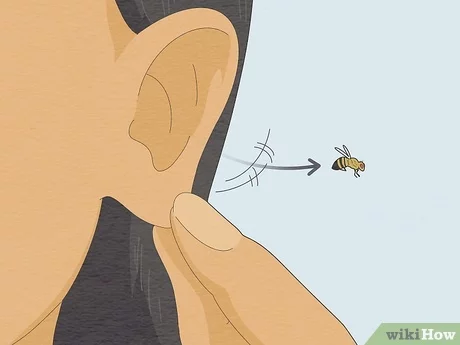1. Identify if you have a bug in your ear.
Your ears can be sensitive for many reasons. They can be tender because of allergies or weather changes. If you have a bug in your ear, you may experience pain, swelling, blood, and crackling. You may even feel biting or stinging. You may also experience hearing loss or dizziness.
2. Stay calm!
While a bug in the ear may be scary, it is best to stay calm in this situation. Being too active may lodge the bug further in your ear or cause it to crawl further back, or cause damage to the sensitive inner ear or eardrum.
3. Avoid using tools in your ear.
You do not want to jam the bug further in your ear or risk accidentally hurting yourself further. There are a lot of nerve endings in the ear. You can damage these nerves by using tools such as cotton swabs or tweezers. Do not try and pry the bug out.
4. Locate the bug.
If the bug has crawled all the way against your eardrum, you may want to consider a trip to your doctor to remove it. Have someone shine a flashlight or a lighted magnifying glass in your ear to attempt to locate and identify the creature. This can help to diagnose the bug’s location as well as the type of bug.
5. Get into a comfortable position. To set up for removal, you want to get into a comfortable position. This might be sitting somewhere comfortable with your head tilted to the side so that you or a friend can easily access the ear. You might find it comfortable to lay on your side with your ear facing the ceiling.
1. Inspect the bug for missing parts.
Make sure that you have removed the entire bug from your ear. If you missed any parts, it may cause further problems such as an ear infection. Carefully inspect whatever objects you remove from your ears.
2. Take it easy.
Removing a live animal from your ear is a stressful procedure. Flushing or suctioning your ears may also cause slight dizziness due to stress on the middle ear. Avoid standing up too quickly and strenuous exercise for at least a day after the procedure.
3. Watch for signs of infection. The bug may have caused damage in your ear before it was completely removed. Signs of an ear infection include pain, itchiness, swelling, and discharge. More serious symptoms may include dizziness, hearing loss, and fever.
4. Follow up with a doctor.
If you are unsure if you have removed all of the insect, or you are worried about infection, make an appointment with your family physician to make sure you are completely healthy. They may refer you to a Otolaryngologist, an ear specialist, for follow up diagnostics.















